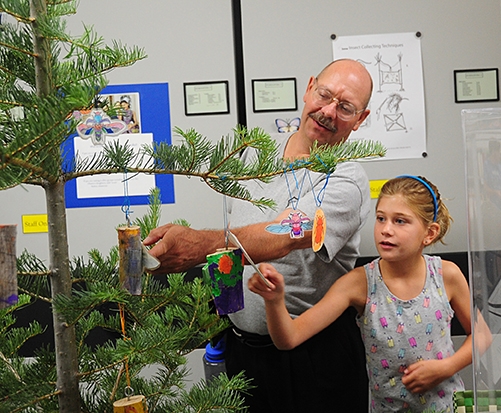
That would be the recent open house at the Bohart Museum of Entomology, University of California, Davis, on "Bark Beetles and Forest Health," coordinated by USDA Forest Service research entomologist/UC Davis affiliate Steve Seybold and his graduate and undergraduate students.
It was definitely a beetle invasion. You couldn't see the Bohart for the trees!
"It was a mixed conifer forest right out of the central Sierra Nevada,” Seybold commented.
“As of last winter, bark beetles had killed 102 million trees in California during the last drought period,” said Seybold, who is a lecturer with the UC Davis Entomology and Nematology. “Tree mortality in the western United States over the past 15 years caused by native bark beetles exceeded 21 million hectares, which surpasses all other disturbances, including fire.”
UC Davis Department of Design emeritus professor and environmental artist Ann Savageau, showcased her wood sculptures patterned with bark beetle galleries. Retired from UC Davis in 2014, she now works as a full-time studio artist.
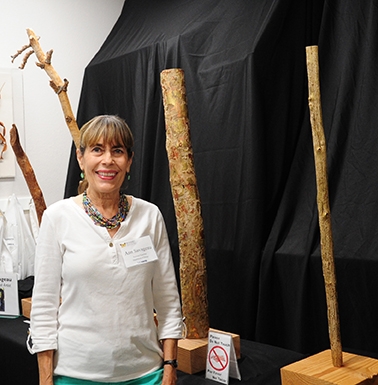
Visitors marveled at the eight-foot trunk sections of mass-attacked conifers as the scientists peeled back bark to reveal larvae of bark beetles and wood borers in their galleries in the phloem and xylem. Visitors also learned about the development of bark beetle pheromones and their release devices, and the role of semiochemicals (behavioral chemicals) to lure and repel the beetles.
One display station zeroed in on the onslaught of invasive bark and wood boring beetles, including the walnut twig beetle, goldspotted oak borer, and polyphagous shot hole borer, all among California's 25 new invasive species.
The scientists warned that beetle-infested firewood can become a “Trojan horse” when campers unknowingly transport beetles from site to site and spread the pests.
Enlarged aerial photos of southern Sierra Nevada forests--taken by USDA Forest Service Aerial Survey Unit in May and August 2016--hammered home the havoc that bark beetles can and do wreak. Visitors also learned about bark beetles via a computer slide show, and looked at specimens of western pine beetle, pine engravers, and fir engravers through a scanning electron microscope (on loan from Hitachi to the museum). The microscope magnified the specimens 100 times.
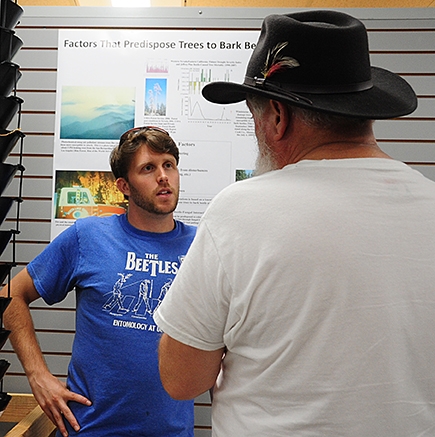
A craft table near Ann Savageau's exhibit featured the family craft activity, "Bark Beetle Art." Children traced and colored bark beetle patterns on paper, and also colored bark beetle gallery patterns on wood samples. Then they hung their art as ornaments on "The Bark Beetle Tree," a white fir.
Entomologist Wade Spencer, a UC Davis undergraduate student and an associate at the Bohart Museum, enthralled the crowd by reading Vlasta van Kampen's children's book, “Beetle Bedlam,” about a bark beetle on trial for killing trees in the forest.
Despite the 107-degree temperatures, the open house drew some 110 visitors, representing Davis, Elk Grove, Fairfield, Pinecrest, Redding, Sacramento, South Lake Tahoe, Vacaville, Woodland, and other cities.
Assisting Seybold were Yigen Chen, formerly with the UC Davis Department of Entomology and Nematology and now with Gallo Wines in Modesto; UC Davis entomology graduate students Jackson Audley and Corwin Parker; UC Davis junior specialist Megan Siefker; UC Davis undergraduate student Crystal Homicz; and graduate student Irene Lona of California State University, Chico.
Representing the Bohart Museum were Lynn Kimsey, director of the Bohart and UC Davis professor of entomology; senior museum scientist Steve Heydon; Tabatha Yang, education and outreach coordinator; and Bohart associates/volunteers Greg Kareofelas, Wade Spencer, Chloe Stott. Riley Gilmartin, Joel Hernandez, Maia Lundy, amd Alex Nguyen.
Seybold credited Rob York, UC Berkeley Center for Forestry, Blodgett Forest Research Station. for providing infested tree and wood samples for the displays; Jeffrey W. Moore, USDA Forest Service R5 Forest Health Protection, Davis for providing the aerial imagery of California tree mortality; and Ross Gerrard, USDA Forest Service PSW Research Station, Davis, for providing the poster-sized photos and illustrations for the exhibit.
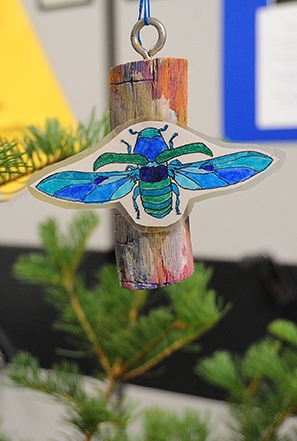
Want to attend the next Bohart Museum open house? It's from 1 to 4 p.m. on Sunday, Sept. 24 in Room 1124 of the Academic Surge Building, Crocker Lane. The theme is "Insects and U" and it's in keeping with the arrival of UC Davis students for the fall quarter. The open house, a family friendly event, is free and open to the public.
"This purposely coincides with UC Davis dorm move-in weekend," said Tabatha Yang. "Our target audience is new students and their families, but everyone is welcome. The focus is how to study insects at home and in school--any age."
Undergraduate advisor Brandy Fleming will be on hand (tabling) to talk about classes, careers, and fun with entomology.
Yang is also planning a display featuring cabbage white butterflies for educators.
The Bohart Museum is a world-renowned insect museum that houses a global collection of nearly eight million specimens. It also maintains a live “petting zoo,” featuring walking sticks, Madagascar hissing cockroaches, walking sticks, praying mantids, and tarantulas. A gift shop, open year around, offers T-shirts, sweatshirts, books, jewelry, posters, insect-collecting equipment and insect-themed candy.
The insect museum's regular hours are from 9 a.m. to noon and 1 to 5 p.m. Mondays through Thursdays. The museum is closed to the public on Fridays, Saturdays and Sundays and on major holidays. Admission is free.
For more information, email the bmuseum@ucdavis.edu or access the website or Facebook page.
Attached Images:
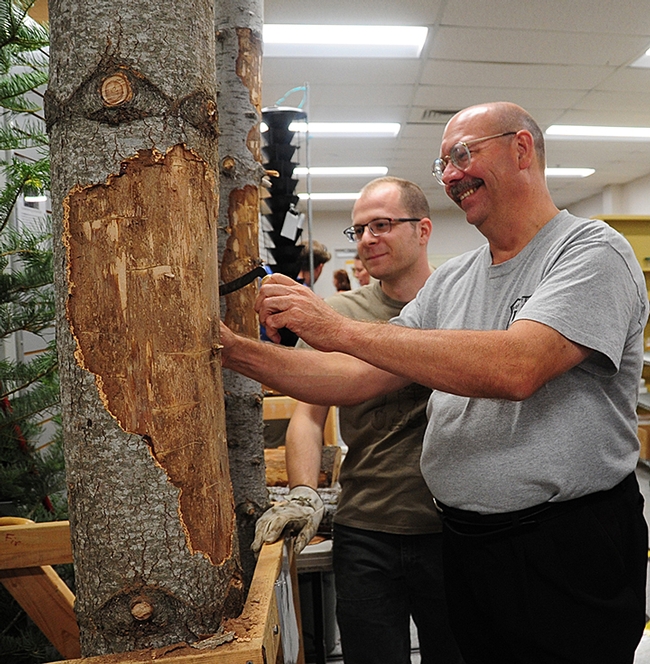
USDA Forest Research entomologist Steve Seybold (foreground) and UC Davis graduate student Corwin Parker peel bark to reveal larvae of bark beetles and wood borers. (Photo by Kathy Keatley Garvey)
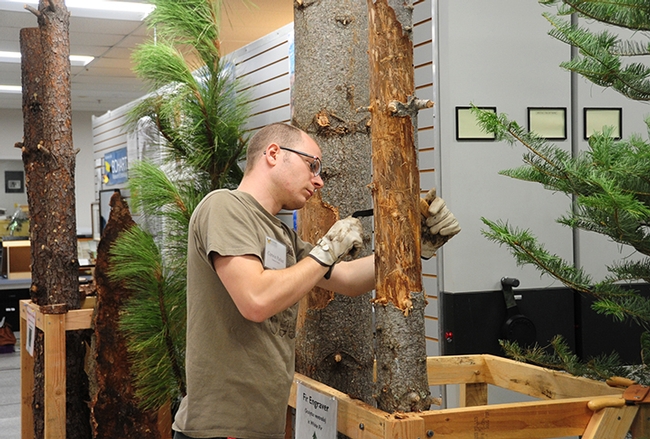
UC Davis graduate student Corwin Parker examines a conifer for beetles. (Photo by Kathy Keatley Garvey)
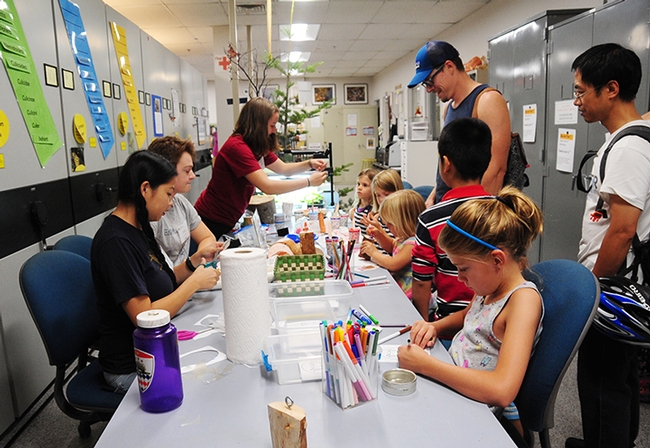
Children flocked to the crafts table to create art focused on bark beetles. (Photo by Kathy Keatley Garvey)
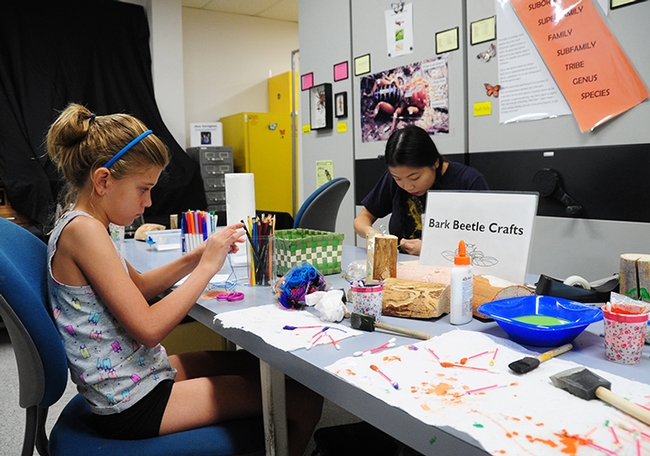
Natalie Seybold (left) works on bark beetle art. In the background is Bohart Museum associate Mai Lundy. (Photo by Kathy Keatley Garvey)
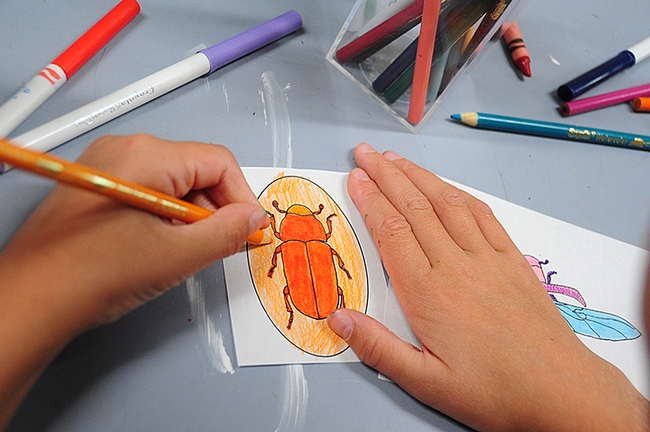
Bark beetle art in the making--this is the work of Natalie Seybold of Davis. She is coloring an outline of a Dendroctonus sp. bark beetle, probably the red turpentine beetle, Dendroctonus valens, or the great spruce beetle, Dendroctonus micans. (Photo by Kathy Keatley Garvey)
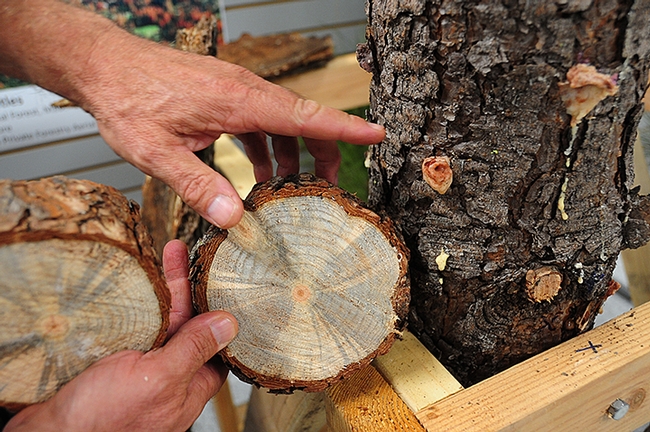
This is staining to a cross section of ponderosa pine, Pinus ponderosa, by a blue-staining fungus carried by the western pine beetle, Dendroctonus brevicomis. In the background: pitch tubes around the entrance holes of western pine beetle, Dendroctonus brevicomis, on the bark surface of ponderosa pine, Pinus ponderosa.(Photo by Kathy Keatley Garvey)
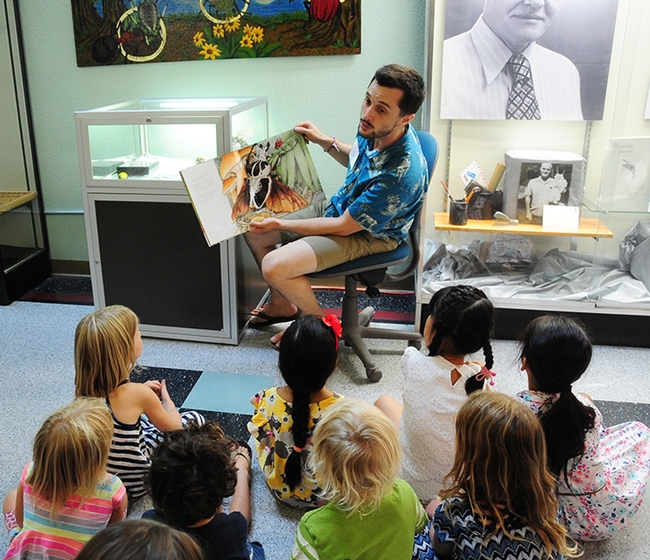
Entomologist Wade Spencer, a UC Davis undergraduate student and Bohart Museum associate, reads a children's book, "Beetle Bedlam." (Photo by Kathy Keatley Garvey)